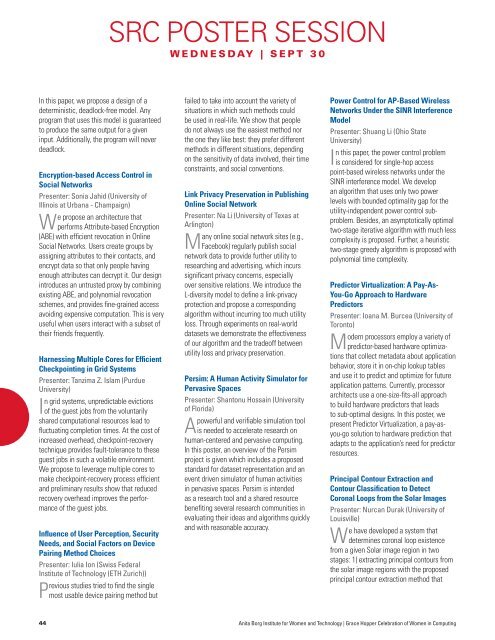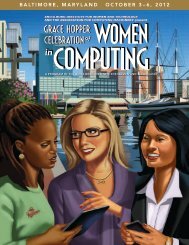ABI-ONE ghc program v14.indd - Grace Hopper Celebration of ...
ABI-ONE ghc program v14.indd - Grace Hopper Celebration of ...
ABI-ONE ghc program v14.indd - Grace Hopper Celebration of ...
You also want an ePaper? Increase the reach of your titles
YUMPU automatically turns print PDFs into web optimized ePapers that Google loves.
In this paper, we propose a design <strong>of</strong> a<br />
deterministic, deadlock-free model. Any<br />
<strong>program</strong> that uses this model is guaranteed<br />
to produce the same output for a given<br />
input. Additionally, the <strong>program</strong> will never<br />
deadlock.<br />
Encryption-based Access Control in<br />
Social Networks<br />
Presenter: Sonia Jahid (University <strong>of</strong><br />
Illinois at Urbana - Champaign)<br />
We propose an architecture that<br />
performs Attribute-based Encryption<br />
(ABE) with efficient revocation in Online<br />
Social Networks. Users create groups by<br />
assigning attributes to their contacts, and<br />
encrypt data so that only people having<br />
enough attributes can decrypt it. Our design<br />
introduces an untrusted proxy by combining<br />
existing ABE, and polynomial revocation<br />
schemes, and provides fine-grained access<br />
avoiding expensive computation. This is very<br />
useful when users interact with a subset <strong>of</strong><br />
their friends frequently.<br />
Harnessing Multiple Cores for Efficient<br />
Checkpointing in Grid Systems<br />
Presenter: Tanzima Z. Islam (Purdue<br />
University)<br />
In grid systems, unpredictable evictions<br />
<strong>of</strong> the guest jobs from the voluntarily<br />
shared computational resources lead to<br />
fluctuating completion times. At the cost <strong>of</strong><br />
increased overhead, checkpoint-recovery<br />
technique provides fault-tolerance to these<br />
guest jobs in such a volatile environment.<br />
We propose to leverage multiple cores to<br />
make checkpoint-recovery process efficient<br />
and preliminary results show that reduced<br />
recovery overhead improves the performance<br />
<strong>of</strong> the guest jobs.<br />
Influence <strong>of</strong> User Perception, Security<br />
Needs, and Social Factors on Device<br />
Pairing Method Choices<br />
Presenter: Iulia Ion (Swiss Federal<br />
Institute <strong>of</strong> Technology (ETH Zurich))<br />
Previous studies tried to find the single<br />
most usable device pairing method but<br />
SRC POSTER SESSION<br />
W e d n e s d ay | s e p T 3 0<br />
failed to take into account the variety <strong>of</strong><br />
situations in which such methods could<br />
be used in real-life. We show that people<br />
do not always use the easiest method nor<br />
the one they like best: they prefer different<br />
methods in different situations, depending<br />
on the sensitivity <strong>of</strong> data involved, their time<br />
constraints, and social conventions.<br />
Link Privacy Preservation in Publishing<br />
Online Social Network<br />
Presenter: Na Li (University <strong>of</strong> Texas at<br />
Arlington)<br />
Many online social network sites (e.g.,<br />
Facebook) regularly publish social<br />
network data to provide further utility to<br />
researching and advertising, which incurs<br />
significant privacy concerns, especially<br />
over sensitive relations. We introduce the<br />
L-diversity model to define a link-privacy<br />
protection and propose a corresponding<br />
algorithm without incurring too much utility<br />
loss. Through experiments on real-world<br />
datasets we demonstrate the effectiveness<br />
<strong>of</strong> our algorithm and the trade<strong>of</strong>f between<br />
utility loss and privacy preservation.<br />
Persim: A Human Activity Simulator for<br />
Pervasive Spaces<br />
Presenter: Shantonu Hossain (University<br />
<strong>of</strong> Florida)<br />
powerful and verifiable simulation tool<br />
A is needed to accelerate research on<br />
human-centered and pervasive computing.<br />
In this poster, an overview <strong>of</strong> the Persim<br />
project is given which includes a proposed<br />
standard for dataset representation and an<br />
event driven simulator <strong>of</strong> human activities<br />
in pervasive spaces. Persim is intended<br />
as a research tool and a shared resource<br />
benefiting several research communities in<br />
evaluating their ideas and algorithms quickly<br />
and with reasonable accuracy.<br />
Power Control for AP-Based Wireless<br />
Networks Under the SINR Interference<br />
Model<br />
Presenter: Shuang Li (Ohio State<br />
University)<br />
In this paper, the power control problem<br />
is considered for single-hop access<br />
point-based wireless networks under the<br />
SINR interference model. We develop<br />
an algorithm that uses only two power<br />
levels with bounded optimality gap for the<br />
utility-independent power control subproblem.<br />
Besides, an asymptotically optimal<br />
two-stage iterative algorithm with much less<br />
complexity is proposed. Further, a heuristic<br />
two-stage greedy algorithm is proposed with<br />
polynomial time complexity.<br />
Predictor Virtualization: A Pay-As-<br />
You-Go Approach to Hardware<br />
Predictors<br />
Presenter: Ioana M. Burcea (University <strong>of</strong><br />
Toronto)<br />
Modern processors employ a variety <strong>of</strong><br />
predictor-based hardware optimizations<br />
that collect metadata about application<br />
behavior, store it in on-chip lookup tables<br />
and use it to predict and optimize for future<br />
application patterns. Currently, processor<br />
architects use a one-size-fits-all approach<br />
to build hardware predictors that leads<br />
to sub-optimal designs. In this poster, we<br />
present Predictor Virtualization, a pay-asyou-go<br />
solution to hardware prediction that<br />
adapts to the application’s need for predictor<br />
resources.<br />
Principal Contour Extraction and<br />
Contour Classification to Detect<br />
Coronal Loops from the Solar Images<br />
Presenter: Nurcan Durak (University <strong>of</strong><br />
Louisville)<br />
We have developed a system that<br />
determines coronal loop existence<br />
from a given Solar image region in two<br />
stages: 1) extracting principal contours from<br />
the solar image regions with the proposed<br />
principal contour extraction method that<br />
44 Anita Borg Institute for Women and Technology | <strong>Grace</strong> <strong>Hopper</strong> <strong>Celebration</strong> <strong>of</strong> Women in Computing




